One of the main activities for wildlife managers in Texas is providing supplemental water for wildlife. Where natural water supplies are abundant and unpolluted, supplemental water may not be necessary, but drought years come to all regions, and wildlife suffer if they do not have access to a reliable, safe, supply of water.
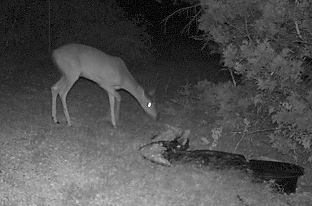
In a drought summer, with all natural water gone, deer made regular use of this small, three-tub water on a rocky knoll. Because of its small size, this waterer needed daily filling through the summer. A small solar-powered pump in the lowest tub circulates the water.
When considering water for wildlife, it’s important to set up a system for reliable (constant) water that is safe for wildlife to use and is provided in containers that allow access by a wide range of wildlife. This means thinking about the water source (rainwater, well water, stored surface water), water quality, and the shape, size, and location of water presentation.
In much of the semi-arid and arid parts of the country, sourcing supplemental water from rainwater collection makes sense–rainfall is sporadic, but may be heavy when it occurs. Puddles dry up quickly; stored water can provide permanent “puddles” for wildlife. Where extreme heat and low humidity cause rapid evaporation, enclosed storage is more reliable than open (pond, stock tank, etc.) storage. Well-water is another water source, but in some areas heavy use of aquifers for human and livestock use means the water table is dropping steadily and water quality is declining. Also some aquifers do not provide quality water: the water is contaminated with too much sulphur and petroleum. Over the long haul, well water is more expensive than rainwater collection, as it requires a pump (and power for the pump), plus piping to the location of the wildlife waterer. Public-system water is expensive and always treated to make it safe for human consumption; this treatment makes it unsuitable for some wildlife.
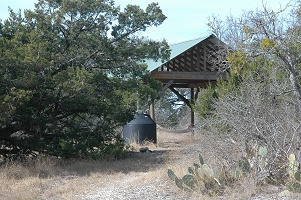
This “rain barn” has a collection area of 400 square feet and two 300 gallon tanks to hold the collected rainwater. Since we installed it, we have not had to haul water to the wildlife waterer despite two years in a row of severe drought. This is Fox Pavilion. and the night photo of the deer shows the layout of the waterer. We have two rain barns complete and one under construction. Owl, the other one, has 5000 gallons of storage capacity and a much larger and more elaborate water feature.
Water quality for wildlife is not the same as for humans: the chlorinated city water most of us drink will kill some wildlife and isn’t good for most of it. We don’t care whether our water is “oxygenated” or not; for some of the wildlife we want to support, the dissolved oxygen level is important. The bacteria and viruses in natural water that make us sick don’t make them sick–or as sick. So the water in a wildlife waterer doesn’t need to be clean enough for us to drink or swim in, but does need to have the characteristics the wildlife need.
That starts with the right pH, a measure of acidity/alkalinity. The water should not be too acidic or too alkaline. Though it’s possible to treat water in a waterer, it’s easier to start with water of about the right pH. Rain is good for that unless you live downwind from a stack releasing a lot of sulphur ions (as from high-sulphur coal.) If using well-water, have it tested for the minerals in it. Wildlife in Texas have no problem with “hard” water with the minerals from limestone in it, but some minerals are not good (and if you live in a part of the west where some springs are bitter and nothing lives in them or drinks from them…that’s what I mean.)
Circulating the water with enough turbulence to increase oxygenation, also helps water quality. So does aquatic vegetation, if not so dense that it prevents good circulation. Water plants use up nitrogen (that the wildlife poop into the water) and provide complex habitat for more wildlife at the same time. In enclosed systems of any size or shape, you need a pump to keep the water moving. Solar-powered pumps work well in remote areas; they must be sized to the amount of water you expect them to move and to the “lift” you want: a combination of the height (from the water surface of the lowest container to the outlet of the system) and the length of pipe between the pump and the outlet. 10 feet of length in the pipe = 1 foot of vertical lift, so a system with 20 feet of pipe and one foot of vertical lift needs a pump that can handle three feet of lift. Luckily, a series of small cascades will do an excellent job of oxygenating the water: four to six inch drops, if sudden, produce the turbulence and bubbles you want.
Once you have a source of good water for wildlife, and a pump to do the circulating, the question becomes how best to lay out the watering space for the wildlife. This depends on what kind of wildlife you want to serve, and that in turn depends on the amount of water you can play with. Our first water station (Fox Pavilion) has only 600 gallons of storage; we put in a small, 45 gallon system (three basins) that serves primarily small birds and mammals (but includes some use by deer.) Due to its size, only a few birds use it at one time, though others will be perched nearby waiting their turn. The large water garden near the house is designed to serve larger numbers of birds, small wildlife (fox, raccoon, squirrel), large game (deer), and also to provide reproductive habitat for dragonflies, damselflies, frogs, and toads. The Owl Pavilion system is designed to serve a larger bird population than Fox, the same variety of mammalian wildlife.
Different birds and animals need different shapes and sizes of water: small birds like warblers and chickadees need shallow water–they will drink from very shallow water and bathe in water an inch to inch and a half deep–while larger birds like white-winged doves like to bathe in water 3 inches deep. Foxes can reach down to drink from water below ground level or step up to a higher rim (or just reach over it), but armadillos prefer water at ground level with a nearly-level entrance.
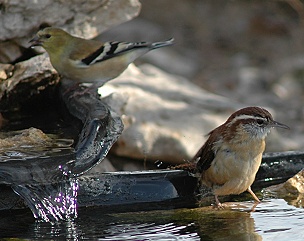
Two small birds (American goldfinch in winter plumage, Carolina wren) are using the small basins at Fox: they maintain spatial separation andthe wren is standing on a rock placed for such use in the deeper middle basin.
Owl Water has a “spring” (the water outlet comes out between two rocks, very popular with small birds) that drips into a deep tub, a “fall” from that into a gravel-bedded shallow pool, an S-shaped “stream” section, and two deep tubs (one with the pump in it) at the bottom. Here it is as we laid it out and tested it, though the “spring” lacks its top rock:
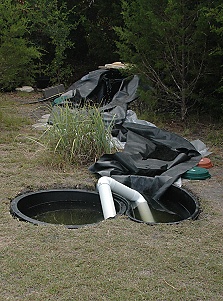
This shows how birds drink from the “spring” (the lower rock has a groove chiseled in it–by me–for the hose)
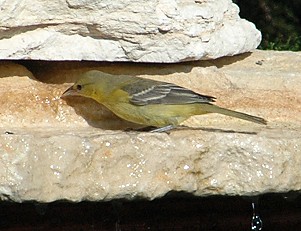
Other birds prefer the stream section.
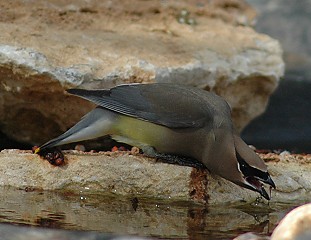
A cedar waxwing uses a flat rock placed in the “stream” portion of Owl Pavilion’s water feature; the rock behind and above it provides a staging area for approach to the water. At this location, the water is shallow enough (the bottom filled with smooth gravel for birds this size and larger to enter the water from the rock, or choose to drink only. Small birds often drink here but bathe on the “beach” across the stream.
But cedar waxwings like to come to water in flocks, and this waterer has room for several birds to drink as a flock:
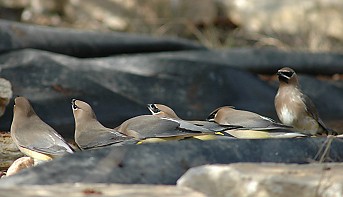
Owl’s more complex water design resulted from several years of watching birds and other wildlife at both natural water (when it existed on the place) and the water at Fox and in the yard. Within the limits of the available water, we’ve been able to provide more attractive and useful water for our wildlife. Fox will get additional storage capacity soon, which may allow expansion of that facility.
Our target species here include the full range of vertebrate and invertebrate natives, but we do not try to provide habitat for fish–the natural water is seasonal at best, and though fish do breed in the creek if it’s running long enough, trying to manage fish in the limited water volume of the supplemental sources would imperil the less common wildlife–amphibians and invertebrates. Instead, we have concentrated on providing habitat for those.
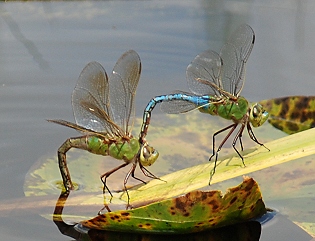
We’ve documented successful reproduction by several species of odonates; their predatory larvae eat mosquito larvae just as the adults eat adult mosquitoes. We’ve identified almost 50 species of odonates (more in wet years, of course; some never show up at the supplemental water.) Many other insects also come to drink (as well as those who live in or on the water)
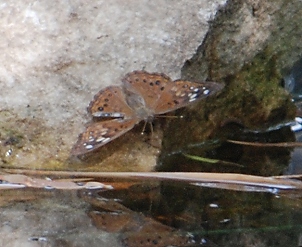
And of course there are the amphibians:
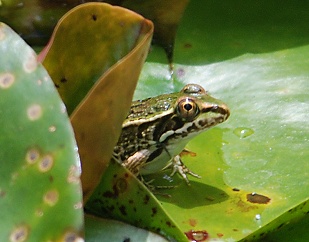
Vegetation in the water provides habitat for wildlife: shelter, a substrate for egg-laying (spreadwing damsels and others), food (young tadpoles eat algae), places to perch. Variation in water depth and velocity, and bottom surface, also provide habitat variety. If possible, the system should have as natural a bottom as possible. Unlike a display pond in an urban/suburban back yard, some debris in a wildlife waterer is both inevitable and healthy: aquatic invertebrate larvae hide in that debris. It’s not necessary to clean out the leaves, etc. on a daily (or even weekly) basis, though it is important not to let the planted aquatic plants choke it out. This pool in the yard water feature was almost entirely full of water iris and pickerelweed, reducing the total capacity of the system and the flow: here it’s been cleaned out and a small planting re-established. In time this will spread and we’ll have to de-bulk it again…but once the iris were back in, the frogs and dragonflies returned.
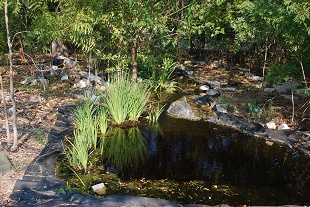
Is it worthwhile to create more complex supplemental water systems than the “guzzlers” found in some sites? It is a lot of work to plan and dig such a system, and more work to maintain that a drip into a single basin. However, it’s clearly more attractive to, and better serves, more classes of wildlife, providing them necessary water in a setting they’ve demonstrated they prefer. This should lower stress on the wildlife and thus improve both survival and reproductive success.
This approach to providing supplemental water has advantages for the manager, too. By designing water features to allow clear sight lines for observers/photographers while preserving the approach cover wildlife prefer, it’s possible to do behavioral observations and census counts (of migrating songbirds, for instance) much more easily. Game-cams aren’t that good at birds, but do record mammals day and night (though in extreme heat, they fail) and water sources are the place to catch just about everything you’ve got (and some things you didn’t know you had.)
Of course we’d like to have abundant natural water–and of course we’ve done what we can to retain surface water runoff on the land, as a wildlife resource in addition to slowing/stopping erosion. But where we live, months of absolute dry are common and our supplemental water features are available when natural water fails.
Comment by gunhilda — September 8, 2009 @ 3:07 pm
Beautiful pictures. I especially like the pic of the cedar waxwing drinking. What is your source for the rainwater collection pavillions and tanks?
Comment by elizabeth — September 8, 2009 @ 4:14 pm
We built the pavilions, from scratch. I designed the first one, Richard dug the holes (which on Fox involved renting a jackhammer to make holes in the rock) to put the upright posts in), tied the frame in, built the trusses and then we got help to put up the roof. We liked the design well enough to use the same design on the others, except that Owl has a deck off one side, both to give us more shade (since Owl’s 2500 gallon tanks sit under the roof and take up about half the area they’re eight feet in diameter) and to give us an elevated viewing platform. That also made putting up the roof easier, though there’s a picture of me bracing a pole on my forehead to hold the end truss on the other end in place until they got the purlins attached to it.
The posts and framing wood are all pressure-treated; the roofs are steel and we paid extra to have them a color instead of just silvery-metal: I chose the soft green to blend with vegetation and not stick out. The underside is white.
The tanks: readily available at many suppliers. We use the nearest, American Fence about 15-20 miles away. We chose the black ones because algae grows like crazy in the light colored ones. You need to be sure you’re getting tanks for potable water, so they’re not leaching bad chemicals into it.
We’re about to have more 2500 gallon tanks delivered, to bring the near-house storage to 20,000 plus.
http://www.plastic-mart.com/class.php?cat=9
Our small (300) gallon water tanks look like the little black one in front in the picture and the 2500 gallon ones look like the big black one in back.
Comment by George — September 8, 2009 @ 6:28 pm
That is all a lot of hard work but it is good to see if working in the worst of circumstances.
Comment by elizabeth — September 8, 2009 @ 7:45 pm
The wonderful Richard has been doing all the maintenance out on the land–I haven’t been past the horse lot gate in weeks–and also did the big clean-out of the yard water garden–all those irises out, muck out of the bottom of the lily pond, etc. He’s amazing. Someday we may actually finish all the edges of everything, but the critters don’t care…
Comment by Delilah — September 9, 2009 @ 6:49 am
I admire what you’re doing and I hope to be able to do it also, someday. This blog is fascinating. I’ve never thought of these kinds of details before, that the layout matters. Wow. You and Richard are amazing people.
I’m going to share this blog on my facebaook! 🙂
Comment by elizabeth — September 9, 2009 @ 7:55 am
For years I thought the typical old round birdbath was what birds liked and was the best design EVER. I dutifully filled the birdbath, scrubbed it out from time to time, and thought I was done. After all, birds drank from and bathed from street puddles…
But then I started watching birds, and learning more about them and about other wildlife (an armadillo can’t get water from the typical “pool on a stalk” birdbath, for instance. So when we built the first of the water gardens, we were already thinking about how the different critters drink. We had a leak last year in the Owl water, and fixing it required moving all my carefully placed rocks at the edge…I haven’t replaced all that (other things, like book deadlines, pneumonia, and then day after day of 100+F temps, in which I can’t lift rocks anymore intervened) but I must get back to it.
Comment by Marjorie Procter-Smith — September 9, 2009 @ 8:15 am
This post is packed with information I haven’t seen anywhere else–especially about water pH and bacteria, differing requirements for different wildlife, and especially the difference between a wildlife waterer and a backyard fishpond! Most of the sites I’ve look at in planning our modest pond are focused on the backyard display pond. Thanks for this! Now, just waiting for the temperatures to drop and a hungry college student to need some extra cash for digging a hole in our concrete-hard clay.
Comment by elizabeth — September 9, 2009 @ 10:45 am
When we started our first pond, all we had were the backyard-pond books and the ranch books on building stock tanks–and never the twain shall meet, really. But in one of the Wasowski books on gardening with Texas native plants (can’t now remember which) there was a picture of someone’s garden up in the high plains with a water feature designed for birds, with some comments on what birds liked/needed. And that got me thinking, and observing and photographing, every kind of “wild thing” I could spot near water, natural or artificial. Somewhere around then, our old concrete birdbath had cracked (I forget how it happened, but it did) and held water about like you’d expect. And we’d had a disaster in the horse lots, when a very thirsty ‘possum managed to get into a 100 gallon Rubbermaid horse trough and drown, while we were away for a few weeks. (Luckily the horses had another water trough!) You’re a country gal too, so I don’t have to describe the disgusting task that followed.
So I had the motivation, the germ of an idea, and then increasingly more data. The pond books were actually more useful; they just needed modification (and breaking some of their “rules”–the idea that you shouldn’t have it in shade is, in Texas, ridiculous. And some of the birding advice on keeping the birdbath far away from cover where cats could lurk is also ridiculous. Birds approach from above, and some species strongly prefer dense cover for their approach to a shallow, shaded pool.
Here are some more tidbits you might find useful. If you want dragonflies & damselflies (and you do, because they eat mosquitoes!) they’ll need emergent vegetation (like water iris) to perch on and to lay their eggs in. Frogs sometimes eat dragonflies & damselflies–somewhere I have a funny picture of a tiny cricket frog who swallowed one too big for its stomach–the tail end is sticking out its mouth, and there’s a distorted bulge along one side of the frog, where the head is. If your pond is all sunny, you’ll get one group of dragonflies, and if it’s all shady, another. The backyard water turned out to have (by accident–I didn’t know anything about dragonflies then) the perfect combination for Neon Skimmers–the males are big and glowing red-orange; the females, when about to lay eggs, are glowing golden-tan with a white stripe on top of the thorax.
For good amphibian reproduction with toads and frogs, you need some algae–the tadpoles both eat algae and use it as cover. The first year in the backyard lily pond, we had cricket frogs and leopard frogs but the cricket frogs can’t reproduce successfully there…I suspect some submarine warfare among the underwater denizens. Dragonfly and damselfly larvae are predacious, and so are some of the aquatic insects, like the giant water bug (toebiter.) Native non-aquatic lizards need very little water, but they will come to water if it’s available with the right substrate (sand preferred over gravel) and a gentle slope (or very slight lip.) Snakes vary–most are quite capable of climbing up over the edge of a tub (somewhere I have a picture of a big western coachwhip proceeding through and across one of the little Fox Pavilion tubs) but your aquatic snakes prefer to enter and leave at near water level…they’re faster that way. Snakes will predate on your frogs and tadpoles, but they stay sized to the size water resource…small wildlife waterer, small snakes. Or that’s been our experience. Red-lined ribbon, two species of garter snake off and on. The more emergent vegetation, the more likely you are to pick up the larger snakes in this class. (Richard found several while cutting out the excess iris, including one *under* the pond liner when he turned it back to fix a leak, surrounded by toads enjoying the cooler, darker, moist environment. We joked about it having its own “herd” of toads.) Turtles–really like a level or gently sloping entrance. They’re pretty well trapped in a vertical side that’s several inches above water level. Turtles will add incredible amounts of nitrogen to your pond, so when ours was too small, we’d remove any wandering turtle and take it down to the south end of town where the creek was deeper. Now we’ll let one stay in the lily pond awhile, but they usually go away on their own.
Insects: bees need water, so the bees that pollinate your garden will come to a water source–you can make that safe for them (and prevent half-drowned bees that sting!) if you have extremely shallow areas where the water isn’t moving too fast, or some surface (water lily leaves, floating algae, fallen leaves, gravel that sticks up but has water between) where they can crawl down and drink safely. Same with wasps. As you probably know, some paper wasps are very good at attacking tent caterpillars in pecan trees–since we built the back yard waterer, we have had *no* trouble with tent caterpillars on the two pecans near it. Butterflies come to water, but really like damp sand and damp rocks, and they also like water with salts in it–not good for other wildlife, but a flat pan–the kind of thing you find to put under a flower pot–with sand or fine gravel in it, and a bit of dirt with some organic salts, maybe even sea salt–not a huge amount, just some sprinkled on one side of the pan and dampened–will attract them. If this is set near your pond, it’s easy to remember to dampen the sand regularly. At water, they need to be able to get to the water or within a half-inch (they can use those long “tongues” to suck it up, but the average butterfly tongue isn’t more than an inch long.
Mosquitoes. Mosquitoes will be a problem most during the first season or two, because you won’t have attracted the mosquito control squad to the pond yet. If you use “mosquito dunk” baits to kill mosquito larvae, you will also kill the dragonfly and other insect larvae that eat the mosquito larvae. Use a mosquito-trap for adults instead for at least a year, allowing the first dragonflies who lay eggs in your pond to develop healthy larvae down there. Adult mosquitoes will still be attracted to the pond as a place to lay eggs, but their larvae will not survive in the pond once there are a lot of hungry larvae of other species in there.
Comment by Marjorie Procter-Smith — September 9, 2009 @ 11:52 am
Okay, I went right out and put a little sea salt along the edge of the shallow plate filled with rocks and water in my herb garden. The wasps already like it; now we’ll see if the butterflies come. (I’ve already added three new butterfly species for the county to the Butterflies and Moths of North American data base!)
Next: since we’re short of trees around the house, we’ll need to put in some shrubs and plants around the pond. Suggestions? And suggestions (in addition to water iris) for aquatic plants?
As for additional resources, except that it doesn’t provide your valuable additional information about water quality and how to attract other species, Backyard Bird Feeder’s Bible (Rodale Press) has a good entry on water features to attract birds. Lots of attention to providing shallow water and rough surfaces and the like. Very DIY.
Comment by elizabeth — September 9, 2009 @ 11:15 pm
Congratulations on adding to the BAMONA data base! That’s serious good work. And thanks for the reference to the Backyard Bird Feeder’s Bible…I don’t know that book.
As for plantings around the pond…depends on the size of the pond, what you can reasonably achieve. If there are any native water sources around, or even stock ponds that haven’t been kept shrub-free, take a look at what grows there. You definitely want native, something that looks like it fits. If it has wildlife food value, that’s a bonus. Another thing to consider is your view of your pond. It’s a ton of work to put in, so you want to get some fun out of it, which means you need to be able to see it…so in putting in plants, consider where you’ll sit with your binoculars or camera (I didn’t, with Fox Pavilion, so the SE corner 300 gallon tank neatly obscures the view of the waterer unless I get out from under the shady roof and sit on an uncomfortable stool in the sun. Don’t make that mistake!) Anyway, you can plant on the far side from where you expect to look…and think about sun angles at that point. (I didn’t, again, on Fox–the waterer is southeast of the rain barn, with the thick cedar bush behind it, which is great for the approaching birds, but means I’m squinting into the sun most of the time. I did much better on Owl, having learned!)
Then you leave a clear “lane” from your chair (and at least another couple of chairs–watching the critters at the water is fun in company if they don’t insist on loud talking) to the water. If you have a tree (or porch, if this is near enough to the house) for shade, you just ensure that there’s no tall grass or bush in the way of your view. Depending on exactly where you are, the soil type, etc., it helps to think in terms of layers of cover near the pond (on the opposite sides…), perching places, etc. If you design a higher side and lower side approach, put the lower side approach on “your” side.
Aquatic plants–if you possibly can, put in a water lily. The flat pads are favorites of young frogs, and they shade the water (thus cutting out sunlight for excess algae and also cooling the water by shading it.) And the underwater stems are good habitat. Water lilies don’t like splashy turbulence, so you’d put it on the far side from where the inflow is. I never had luck with the underwater, completely submerged plants. There’s a nice yellow-flowering one that grows in shallow water (and dies back when the leaves get eaten up by beetles, but it comes back.) I can’t think of the name; we got it in a garden center. Oh, and mint–mint will grow in shallow water and smells wonderful (and you can use it.) I need to replant it–we didn’t get it back in the water fast enough in this summer’s cleaning-out. Pickerelweed, a native, is not as aggressive as water iris, has different shaped leaves, and interesting flowers.
(It’s after midnight, I was just informed. So it is. We got home late from choir practice and grocery shopping and I didn’t realize…)
Comment by Marjorie Procter-Smith — September 10, 2009 @ 8:59 am
Thanks! (Sorry to keep you up…)
Comment by elizabeth — September 10, 2009 @ 9:24 am
You didn’t keep me up–not noticing the time kept me up. We were singing Purcell, in preparation for doing an all-Purcell Evenson service on All Saint’s Day, which wakes up the mind wonderfully. (Rutter and Moe, not so much.)
Comment by source.of.all.trouble — September 13, 2009 @ 5:30 pm
Thanks for the tip on the mosquito dunks.
Comment by elizabeth — September 13, 2009 @ 8:48 pm
Someday we’ll have stuff targeted to species, that’s safe to use around the species we want. Maybe. But in the meantime…I’ve become very wary of stuff that I once thought was “safe” because the way it was marketed, it seemed safe. Some of my graduate school work was an eye-opener in that regard.